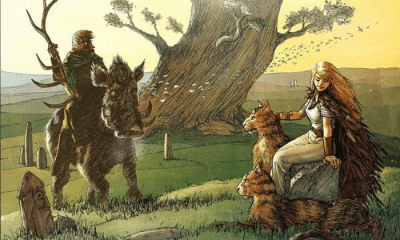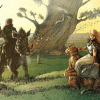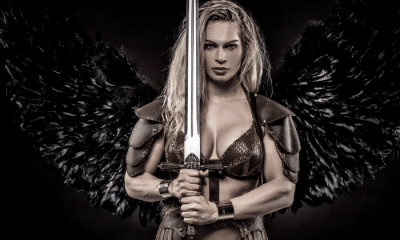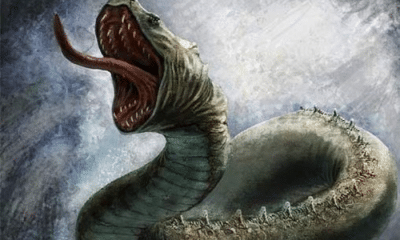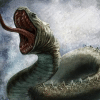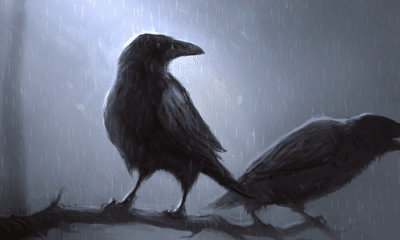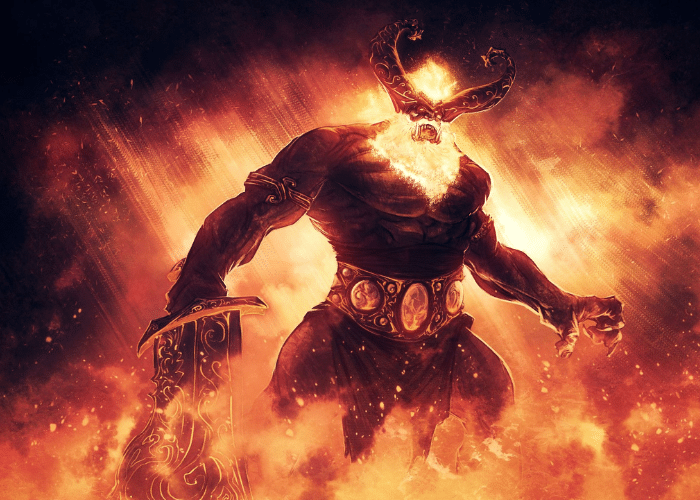
Norse
The Giant Surt and the Armies of Ragnarök
The Giant Surt and the Armies of Ragnarök
You know about the battle of Ragnarök, but how well do you know the leader of the gods’ enemies?
Surt was the commander of the fire giants who would lead his people against the gods in their final war.
By far the most significant event in Norse mythology was the battle of Ragnarök. The last battle between the gods and their assorted enemies would destroy the world of men and kill nearly all life.
One of the most powerful of those enemies was Surt, whose name was written as Surtr in Old Norse. The leader of the fire giants, his army would pour out of Muspell and cover the land in flames.
While Surt plays a major role in Norse mythology’s most important story, little is known about the giant leader himself. From his origins to his appearance, Surt is a mysterious enemy.
The Land of Surt
In Norse cosmology, the land of men was only one of nine worlds that existed. Many of the other worlds were inhabited by other races.
The two tribes of gods had their own worlds, with Asgard being the home of the dominant Aesir. Elves, dwarves, and the jötnar, or giants, had worlds as well.
Along with these worlds were two primordial realms – the icy land of Niflheim and the fiery inferno of Muspelheim.
These realms were not without inhabitants, however. Niflheim was generally believed to be the location of Hel’s land of the dead, while Muspelheim housed a race of jötunn commonly referred to as the fire giants.
These giants were of a different race, or at least a different tribe, than the other jötnar. While most lived in the world of Jötenheim in the east, the so-called “sons of Muspel” were said to come from the south.
And while some jötnar were on good terms with the gods, even marrying into the Aesir and Vanir pantheons on occasion, the giants of Muspelheim were entirely antagonistic. Although written legends do not clarify how the fire giants and those of Jötunheim were related, it is undeniable that they were of two different types.
According to the Prose Edda, Muspelheim was completely inhospitable to any being that was not native to the fiery realm. Despite this, it was still guarded.
The fire giant Surt was positioned at the frontier of Muspelheim to keep anyone else from venturing into it. Surt guarded his realm with a flaming sword and would patrol its borders until Ragnarök began.
The Meaning of the Giant’s Name
Surt’s name, some historians believe, references his fiery homeland.
In Old Norse, the adjective surtr translates as “black.” In referent to the giant this is sometimes more poetically written as “the swarthy one.”
Artistic representations of the giant usually follow this description. He is typically shown as a large man with thick black hair and often an unkempt black beard.
Some scholars believe, however, that Surt’s name may serve a more symbolic purpose.
While some characters in Norse mythology are identified by their hair color, for example Odin often goes by Hárbarðr (Grey Beard) when disguised as a human, it is possible that Surt’s black imagery did not refer to such mundane characteristics.
Instead some historians believe that it should be more closely translated as “charred” or “blackened” rather than simply referring to a color.
Because Surt is the leader of a race that comes from a realm of extreme fire and heat, they think that his name may reflect how his entire body looks rather than just his beard.
The jötnarr of Muspelheim, these historians believe, would have been imagined to be entirely burned and charred by their environment. Surt may have looked more like a burned corpse than a muscular living man.
Surt’s Arrival on Midgard
While Surt was believed to be extremely old, he would not play a major role in the events of Norse mythology until the invasion of Ragnarök began.
One of the major events leading up to the war would be the march of Surt and the giants of Muspelheim toward Midgard.
Surt would be their leader and would stand at the front of their army with his flaming sword. It would shine more brightly than the sun, which would soon be swallowed by the wolf Hati.
Surtr moves from the south
with the scathe of branches:
there shines from his sword
the sun of Gods of the Slain.
-The Poetic Edda (trans Dronke)
When the giants reached the Bifröst, the rainbow bridge that connected Asgard and the land of men, Ragnarök would officially begin. Heimdall would see them coming and sound his horn, alerting the gods to Surt’s arrival.
The Bifröst would collapse beneath the giants as they attempted to cross it, severing the link between the gods and Midgard. As the world burned behind their advance, Surt’s army would continue toward Vígríðr, the vast plain where the gods would meet them for the final battle of Ragnarök.
The Armies of Ragnarök
The sons of Muspell would not be the only army that would converge on Midgard and the gods at Ragnarök, however.
Among the fight would be:
- The armies of men – Before Surt led his people out of Muspel, mankind would have been at war with itself for many years. Men would become entirely lawless and uncivilized so they would have almost destroyed themselves before Ragnarök officially began.
- The warriors of Hel – Those who had been sent to Hel’s realm would march behind her out of Niflheim to fight against the surviving men and gods. They would be joined by her fearsome hound, Garmr.
- Loki’s crew – Loki would break free of his bonds and reemerge aboard the Naglfar, a ship made from the nails of the dead. Among his crew would be frost giants and dead criminals and traitors.
- The Einherjar – Fighting on the side of the gods would be the honored dead who had been chosen for a place in Valhalla.
- Other allies of the gods – Little is recorded of what role the dead who were taken to other halls of the gods would play, but it is likely they would join the gods at Ragnarök as well. These would include Freyja’s noble fighters at Fólkvangr and the drowned men claimed by Ram.
These massive armies, along with those of Surt and the gods, would be joined by many individual creatures.
The serpent Nidhogg would bring poison from Niflheim. Hati and Sköll would swallow the sun and moon.
Jörmungandr, the massive sea serpent, would bring floods and crush mountains when he hauled himself onto land. His brother Fenrir, the wolf, would break free of his chains and rampage across Midgard.
The Death of Surtr
Most of these forces would meet on the field of battle for their final fight.
Fenrir would kill Odin and all of Valhalla’s warriors before being slain by Odin’s son Viðarr.
Thor would kill Jörmungandr but succumb to the serpent’s venom just a few steps away from its body.
Garmr and Tyr would both die, tearing each other to pieces.
Heimdall and Loki would face off and kill one another as well.
Surt, however, would not be fighting on the field of Vígríðr.
Instead, he would remain on the ruined arch of the Bifröst. This would give him a commanding view of the carnage that was unfolding beneath him.
He would not be free to take in the scene, however. Freyr would chase him over the bridge and the two would fight each other at its summit.
Surt and Freyr would have one of the most vicious fights of the entire battle. As gods, men, and monsters died beneath them they would continue to fight.
Freyr, however, would have one disadvantage.
He had once possessed a sword that would fight on its own if the man who carried it was wise. He had given this sword away, however, to win Gerðr as his wife.
With an ordinary sword Freyr was trapped in a long and exhausting battle with the chief of the fire giants. If he had not given away such a powerful weapon, he could have easily won the fight and survived Ragnarök.
Instead, he and Surt would fatally wound one another. Both would collapse on the Bifröst and die as the great battle of Ragnarök ended.
While Surt never speaks in any recorded legends, however, the scene of his death provides one insight into what kind of character he was.
Surt was stubborn enough that he refused to die until the battle was completely over. The leader of the fire giants did not succumb to his wounds until the world was entirely consumed by the flames his people brought with them.
The Giant’s Unknown Origins
In looking at Surt’s role in Ragnarök, historians have been left with the question of where the giant originated.
Typically, fire giants and similar creatures are associated with volcanos. The Greek giant Typhon, for example, was often said to have been imprisoned below Mount Etna.
This has led some historians to theorize that Surt was inspired by the active volcanoes of Iceland. The giants of Muspelheim could not have been native to Sweden, Norway, or Denmark because there are no volcanoes within hundreds of miles of those countries.
Others, however, see the Icelandic explanation as unlikely because of the island’s history.
Iceland was not settled by Norse people until the year 874 AD. Surt is a widespread figure in poems from less than a hundred years later, and some historians believe it is unlikely that Iceland’s volcanoes could have inspired such a well-established character in under a century.
They propose that Surt was instead based on the same archetype as Typhon and other European fire demons. While the Norse people had no direct knowledge of volcanoes, the idea of the fire monster remained in their cultural consciousness.
It may have been enhanced by knowledge, even second-hand, of Southern Europe. Stories of volcanoes closer to the Mediterranean may have made their way to Scandinavia, although it seems unlikely that they would have had enough impact to inspire such a major story in their mythology.
It is more likely, however, that this occurred by the time the Eddas were written in the 13th century. Snorri Sturluson shows knowledge of Roman mythology in his writing, so he likely had some knowledge of their fire giant archetype.
Others, however, believe that Surt and the other fire giants were not truly developed at all until this time in any sense other than the name. Some historians see clear parallels to the depictions of the jötnar in Ragnarök and stories from Christianity.
Surt’s flaming sword, for example, brings to mind the angel who guarded the Garden of Eden in the Book of Genesis. The giants of Muspelheim seem to have less in common with other jötnar in Norse mythology than they do with early medieval depictions of Satan and demons in Christianity.
There is, therefore, no consensus over how and when Surt and the role of the fire giants in Ragnarök developed. Because there are no records that survive before the 10th century, it is impossible to say whether he developed before the colonization of Iceland or after.
Perhaps the most likely explanation is somewhere in the middle.
It is possible that Surt existed before the settlement of Iceland, albeit in a slightly different form. When the Norse gained first-hand knowledge of volcanos they applied this new danger to a character that already resembled the fire monster archetype in other ways.
By the time the Eddas were written in the 13th century, further Christian influence had changed the character even more. Surt may have kept his name but had an almost entirely different image than he had three or four hundred years before.
Surt and the Fire Giants
Surt was the leader of the fire giants, a type of jötnar that were almost entirely different than those that occurred in other myths.
Instead of Jötenheim, they lived in the primordial fires of Muspelheim. Some interpret Surt’s name, which means “black,” as a reference to burning or charring.
Surt guarded Muspelheim but would leave his position at Ragnarök. As the final battle drew closer he would lead the fire giants to Midgard to wage war against the gods.
They would be joined by many other armies, but Surt and his giants would play the largest role of any of the god’s opponents. Their march on the Bifröst bridge would cause Heimdall to blow his horn, officially announcing the start of Ragnarök.
The bridge would shatter beneath them but Surt would hold his position on the rainbow. His opponent would be Freyr who would not be able to defeat him easily because he had given away his magical sword.
Surt and Freyr would have a long and grueling fight before they both eventually succumbed to their injuries. Surt, however, would refuse to die until the battle had ended and he could see the world of men entirely consumed by flames.
While Surt’s role in Ragnarök is well-documented from at least the 10th century, historians cannot agree on how the character developed.
One of the prevailing theories is that his story spread quickly out of Iceland, which created the race of fire giants in response to local volcanic activity.
Others, however, believe the story to be older and passed down from an Indo-European archetype.
In surviving documents, however, there is also obvious influence from both Christianity and Greco-Roman religion. These cultures would have been far less familiar in the Viking Age but influenced the ideas of the 13th century writings that survive today.
It is likely that Surt evolved over time to reflect new experiences, threats, and beliefs. While he was always the giant who would spark Ragnarök, the details of the story were constantly changing.


